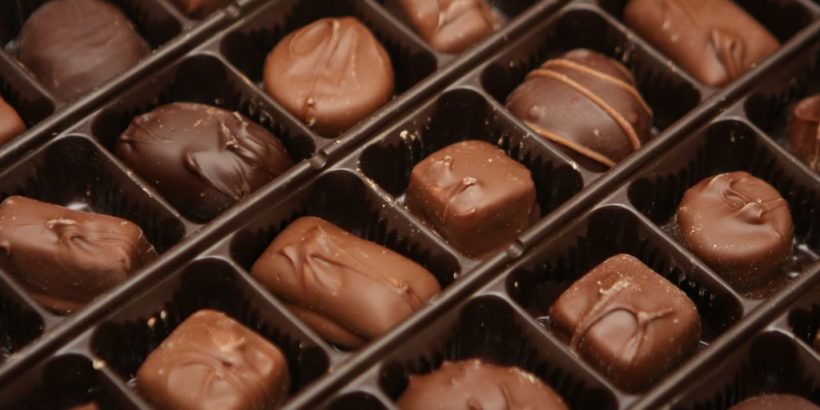If you’re like me, a chocolate lover and frequent traveler, you’ve probably brought your fair share of chocolate back home during your travels.
Or, you might be a first timer and wondering is it that easy to bring chocolate through TSA and onto a plane? And can certain types of chocolate such as fudge be a bit problematic?
Below, I’ll break down everything you need to know about bringing chocolate onto a plane.
Table of Contents
Can you bring chocolate through TSA and onto a plane?
Yes, you can bring chocolate through airport security and onto the plane with you. However, if your chocolate is in liquid (or semi-liquid) form it will be subject to the TSA liquids rule.
Also, you should consider that some types of chocolate such as fudge and different powder forms, can trigger enhanced screening.
And finally, be aware that some chocolate-related products may require a permit and must be declared when coming back from international destinations.
Types of chocolate
There are a few different types of chocolate including: milk chocolate, dark chocolate, white chocolate, and the recently discovered ruby chocolate (yes, if you don’t know a new type of chocolate was discovered in 2017!).
The type of chocolate you bring is less relevant than the form the chocolate is in when going through TSA airport security. What really matters is whether or not you are bringing in solid or liquid forms of chocolate or some type in-between.
Keep reading below to find out how TSA will handle your chocolate.
Tip: Use the free app WalletFlo to help you travel the world for free by finding the best travel credit cards and promotions!
Solid chocolate
Good news chocolate lovers: you can bring unlimited amounts of solid chocolate in your carry-on or checked baggage.
This means that you have very little to worry about when bringing things like:
- Candy bars
- Chocolate bark/chips
- Boxes of chocolates
- Chocolate cookies
- Chocolate cakes (but see below)
When bringing food through TSA, I always recommend to put it in its own separate packaging and remove it from your carry-on bag when it is screened just to make things as seamless as possible.

The melting problem
The biggest problem you’ll likely encounter when traveling with chocolate is that it could melt.
Certain types of chocolate melt quicker than others and it depends on the composition of the chocolate. For example, dark chocolate tends to melt faster than milk chocolate.
The consensus seems to be: the higher the percentage of cocoa butter (or fat) that the chocolate item contains, the faster it will melt.
The average melting point of chocolate is between 86º to 90ºF (30º to 32ºC).
However, the composition of chocolate can be quite complex and a lot of different factors can affect the temperature at which it will melt.
So unless you’re an experienced chocolatier, you may not be able to accurately predict the melting point for your chocolate goods.
Because melted, re-hardened chocolate just isn’t the same, a lot of people choose to transport their chocolate in a carry-on where they can better control the temperature.
You could put the chocolate in your actual carry-on bag, inside your personal item such as a backpack, or in some cases bring it in its own separate bag.
Storing it in checked baggage means that it could be exposed to really hot temperatures especially if you’re flying in a hot area during the summer.
In the past, I’ve transported chocolate in my checked bag successfully on a few occasions.
I basically brought back truckloads of Kit Kats from Japan, dozens of Tim Tam boxes from Australia, and bricks of chocolate back from Oaxaca, Mexico.
I never had any issues with melting so I know bringing chocolate in a checked bag can be done.
If you worry about melting, one trick you can do is to freeze your chocolate before you travel and place them in a bag. You can do this regardless of whether you are storing your chocolate in your carry-on or checked bag. Just be aware that cooling chocolate can affect the flavor.
You could also place the chocolate items inside of a container with an ice pack.
Frozen liquid items such as gel packs are allowed through TSA as long as they are frozen solid. (If the pack is partially melted when going through security, it will have to abide by the liquids rule.)
When in the cabin, try to keep your chocolate away from direct light exposure as that could also cause melting issues.
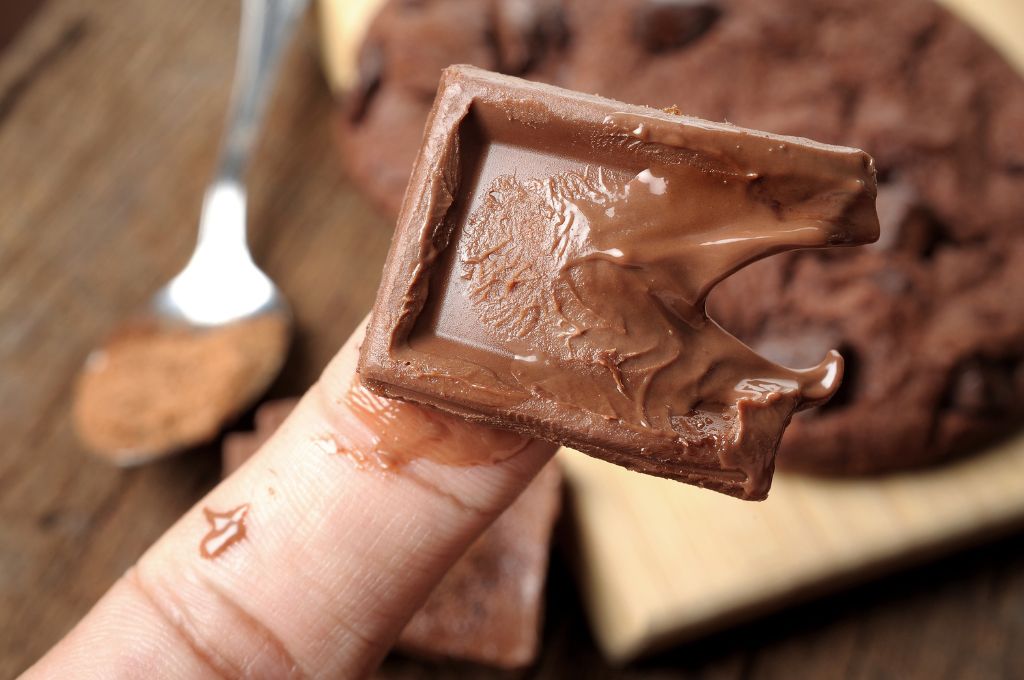
Edibles
If you’re planning on traveling with solid chocolates containing THC then be sure to read our full guide on traveling with marijuana.
In some cases, you might be able to transport your chocolate edibles without any risk of getting into legal trouble but in other situations you could be risking your freedom.
Tip: If putting chocolate in checked baggage, remember to wrap it up safely with clothing or bubble wrap to prevent the chocolate from getting broken up.
Liquid chocolate
If you’re traveling with chocolate in liquid form in your carry-on then you have to abide by the TSA Liquids 3-1-1 Rule which states that you can only bring liquids in containers no larger than 3.4 ounces and that all of your liquids must fit “comfortably” into one clear, quart size bag.
This rule would apply to things like:
- Chocolate syrup
- Chocolate sauce
- Cocoa butter
- Chocolate milk
- Nutella
So if you wanted to bring these things through airport security as a carry-on, you will have to limit them to the small 3.4 ounce containers and only bring enough that can fit in a quart size bag.
But if you placed them in your checked baggage you could go over the size requirements.
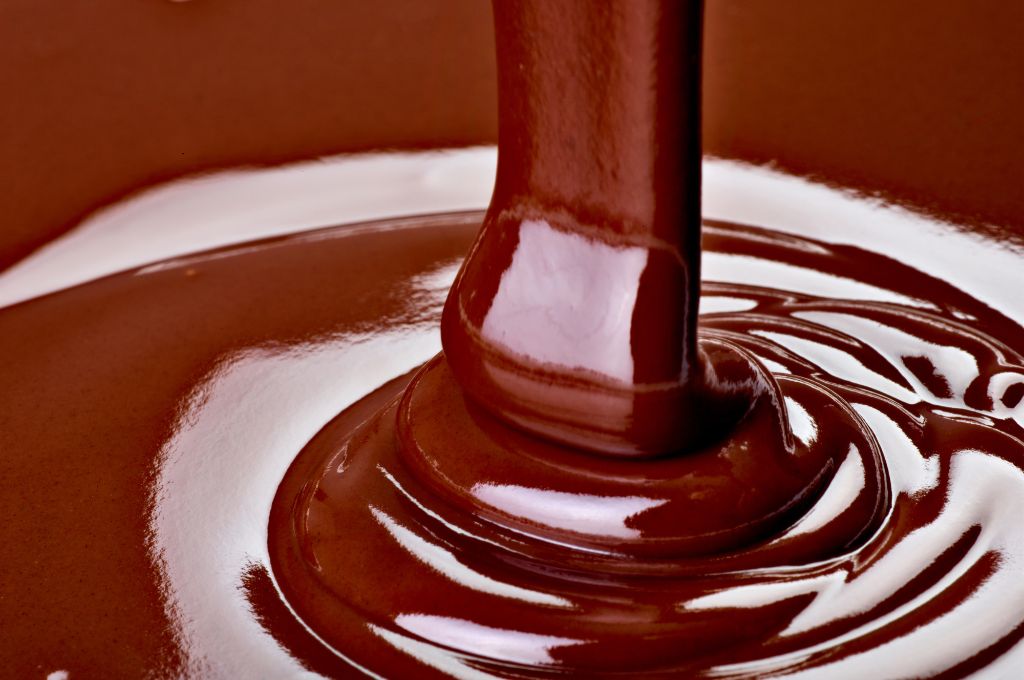
TSA considers many “in-between” food items to fall into the liquids category.
These include things like:
- Creamy dips and spreads
- Mashed fruits such as applesauce
- Gravy
- Honey
- Jam and jelly
- Maple syrup
- Oils and vinegars
- Peanut butter
- Wet pet food
- Salad dressing
- Salsa and sauces
- Soups
- Yogurt
Basically anything that is usually poured, pumped, scooped, squeezed, slurped, or mashed will be considered a liquid for TSA purposes.
But what if you’re traveling with something like a cake that mixes a solid (the cake) with a liquid (the frosting).
The official AskTSA Twitter account provided guidance on this in the past and stated that you could bring cupcakes with frosting and that they are NOT restricted by size or quantity.
In other words, the liquids rule will not apply.

There are a few major things to point out about this.
First, this only mentions cupcakes but I would assume the logic would also apply to other similar foods like cakes, pies, donuts, pastries, etc.
Second, if you are bringing frosting by itself that would be considered a liquid and subject to the liquids rule. So a container of frosting would have to be under 3.4 ounces.
Third, there are mixed online reports about TSA agents not following this type of policy. I’ve seen people that reported they were told to throw out cupcakes or donuts because of the “liquid” frosting/filling.
In the end, it probably comes down to the agent’s discretion, so just be prepared to ditch your frosting.
It probably also helps if you limit the quantity of these items you’re trying to bring.
Bringing two cupcakes will probably draw less “liquids attention” than two dozen cupcakes with 5 swirling inches of frosting.
One last thing about frosting.
Frozen frosting is allowed in carry-on bags and can exceed the 3.4 oz per container rule as long as it’s completely frozen solid when presented for screening. In other words, freezing frosting turns it into a solid for TSA purposes.

What’s the deal with fudge?
Fudge, including chocolate fudge, could be a problem when going through airport security on occasion.
The issue is that it has a density similar to certain types of explosives, such as C4.
So basically whenever it goes through the x-ray it looks like something that could cause catastrophic damage to something other than your diet.
Airports like Chippewa County International Airport have taken this seriously in the past and even posted signs that read:
“Please remove fudge from your bags.”
Some people claim this is no longer an issue.
However, as recently as the summer of 2022, I’ve been questioned about fudge at a security checkpoint so I know this is still something that goes on, at least in airports close to towns known for their fudge.
The same issue also sometimes happens to people bringing in cheese.
To avoid enhanced screening you could always remove your fudge so that it can be easily viewed and it’s always a good idea to maintain original packaging just to make things easy.
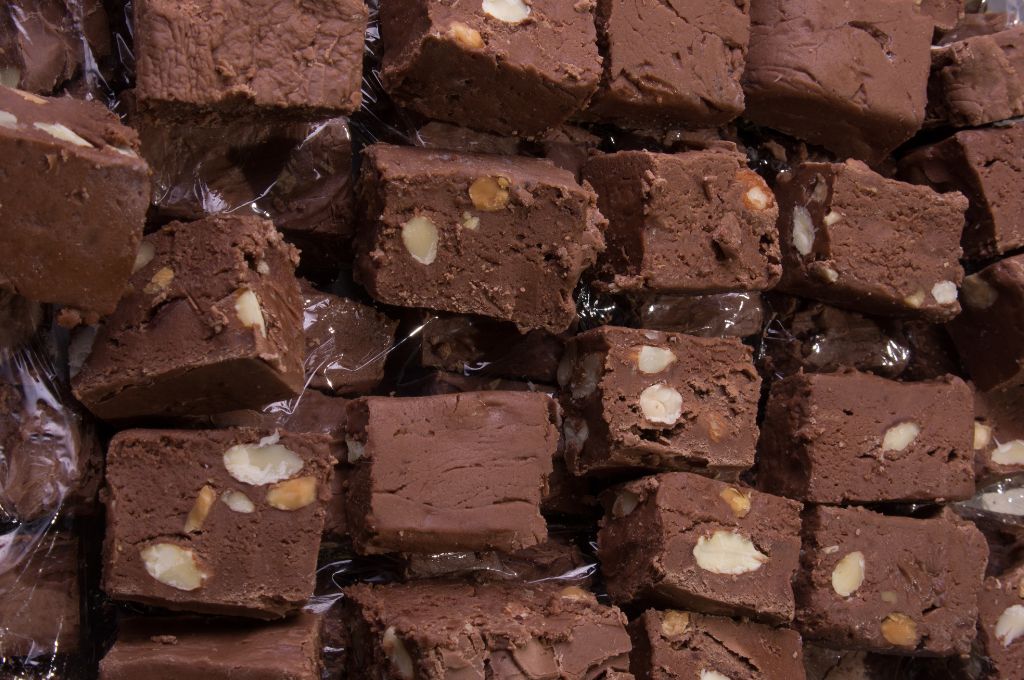
Cacao/cocoa powder
If you’re hoping to bring something like cacao or cocoa powder through airport security you should still be okay but there are some things to consider.
Bringing large amounts of powder in your carry-on could increase the chances of you having to go through additional screening.
Because powders are used in explosives, powders can sometimes slow you down through security.
If your cacao powder is in its original packaging, it would likely be easier to get through the screening since you can simply refer them to the packaging’s label.
Worst case scenario is probably that they let you through after taking a small sample to test.
Keep in mind that TSA states:
“Powder-like substances greater than 12 oz. / 350 mL must be placed in a separate bin for X-ray screening. They may require additional screening and containers may need to be opened.”
To make things easier for yourself, TSA encourages you to “place non-essential powders greater than 12 oz. in checked bags.”
Whether or not your precious cacao powder is “essential” will be up to you.
If your cacao powder is in your checked baggage and TSA wants to take a sample it’s possible that they could poke through the bag which could spill contents out.
So you may consider double bagging your cacao powder or putting it in a hard sided container. Read more about the tips for traveling with protein powder as those can apply to this situation.
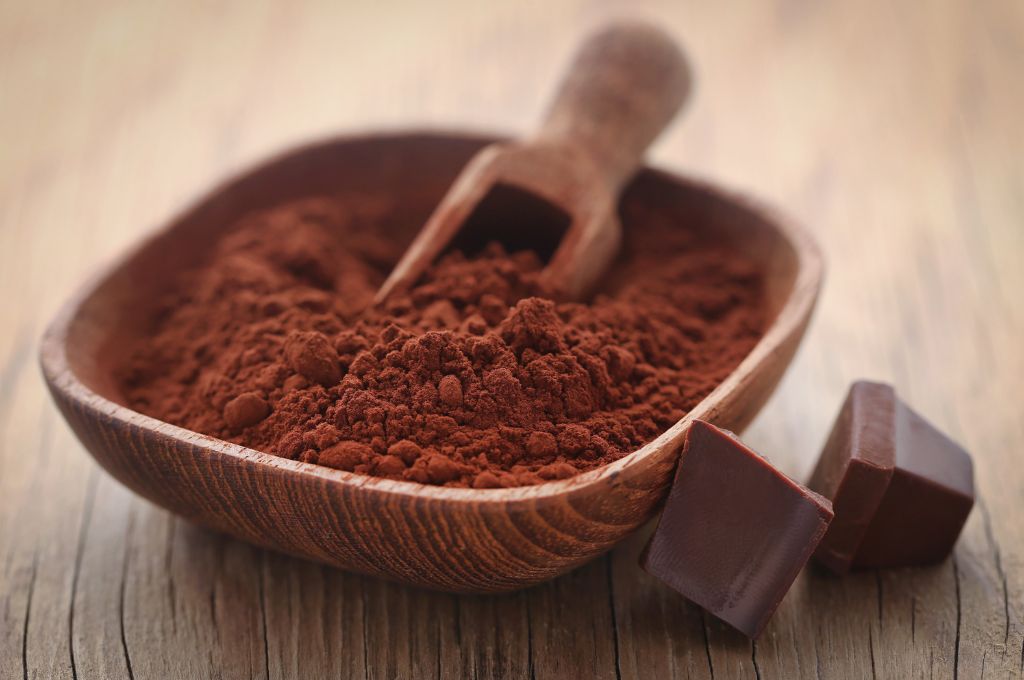
Chocolate and international travel
When you come back into the US, you have to declare all foods you are bringing with you when going through customs. This includes chocolate, even if you purchased it at the duty-free shop.
In some cases, you might also need a permit for certain chocolate related products and I’ll hit on those below.
Related: US Customs at the Airport: What You Need to Know
Cacao beans and pods
If you are bringing cacao beans or cacao pods from an international destination then be sure to declare them and apply for any necessary permits.
Some of these items may need a permit depending on where they are coming from and where you are arriving back in the US.
For example, let’s say you wanted to bring cacao pods from Ecuador, you are going to most likely need a permit for that.
But other items like cacao beans may not require a permit.
And just remember, the permit does not guarantee that you will be able to get the items through customs. Customs will have to inspect your items and make a decision on whether or not the items can come through.
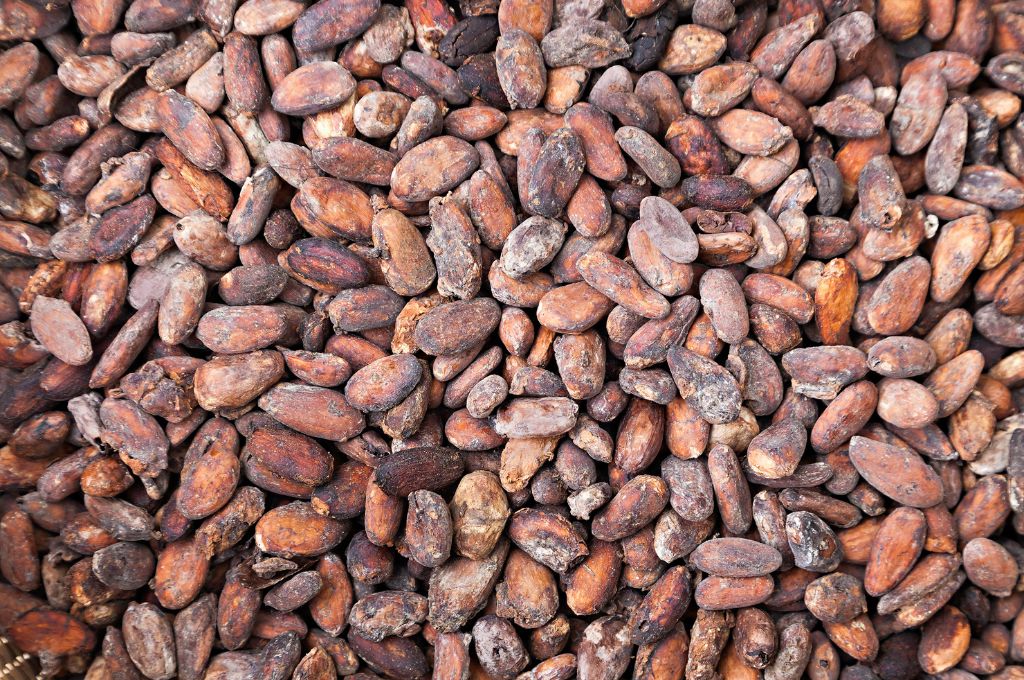
Chocolate covered fruits and nuts
Bringing chocolate covered fruits and nuts through an airport on a domestic trip should not be a problem but whenever you are traveling internationally or between the mainland and Hawaii make sure you are aware of potential restrictions.
If you’re bringing chocolate covered items that are already in a sealed package then you likely don’t have much to worry about. Just be sure to declare it.
But if you are dealing with chocolate covered fresh fruits like strawberries then you probably will need a permit for those.
Chocolate covered nuts are often not an issue but some of them like chestnuts or those that come with shells can sometimes be a problem.
The biggest advice I can give is to just contact the USDA if you have questions about chocolate items coming in from international destinations.
The live representatives can be extremely helpful and you can contact USDA’s Plant Import Information Line at 877-770-5990 (Toll-Free) or by email at [email protected].
And of course, if you’re flying into foreign countries from the US always make sure you are aware of their customs laws regarding bringing in food of any type.

Final word
You can bring lots of different types of chocolate with you through TSA security without any problems.
If you are bringing liquid forms of chocolate then be sure you are complying with the liquids rule. If you are flying with fudge or cocoa powder just be prepared for enhanced screening in some cases.
And finally, if you are bringing chocolate products back from an international trip be aware that you might need a permit and that some types of items like fresh fruit or shelled nuts might be problematic.
Daniel Gillaspia is the Founder of UponArriving.com and the credit card app, WalletFlo. He is a former attorney turned travel expert covering destinations along with TSA, airline, and hotel policies. Since 2014, his content has been featured in publications such as National Geographic, Smithsonian Magazine, and CNBC. Read my bio.

